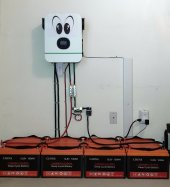I am a total newbie so please if you reply to me, talk to me like I am a child!
I live in the desert, my electricity bill was $641 this month. I have no interest in leasing a big solar system, or buying a system from the loan sharks!
However, I am interested in taking advantage of the sun and the extra space I have to put some solar panels, if I can get the energy back into my home without having pull permits. Is this possible? Anything is possible, right?
I did a little Googling and You-tubing, but it kind of confused me more! Any ideas for me? Thanks!
Hi LosFelizGirl,
Yes, anything is possible.
You need:
quite a lot of panels
inverter(s)
a switch to go from utility power to your own power
wiring
Most likely you, or your electrician friend, already know all this.
How many panels, if any, you can get away with setting up at your place depends on how nosy the utility, city, county is, and whether your neighbors rat you out. This depends on the level of privacy at your place.
What inverter you need depends on the power consumption of whatever you want to power yourself.
The "switch" you use depends on how automated you want things to be and how much manual effort you are willing to put in.
The complexity of the wiring depends on your level of risk tolerance, and how automated you want the system to be.
Some of the answers to these variables will determine what you can/cannot do, and what you need/want to do.
Your privacy situation and how much you can/want to spend will determine what you can/cannot do.
You may have watched DIYSolar founder Will Prowse's videos. He does things to various levels of complexity and really knows what he's doing. At the most basic level he has laid out panels on the ground in his walled yard in order to power devices in his workshop. So, yeah, anything is possible.
Aloha.
. I have absolutely NO idea what "11000W / 200W per m^2 = 55 m^2" means, and what your last paragraph means either. Literal newbie.




